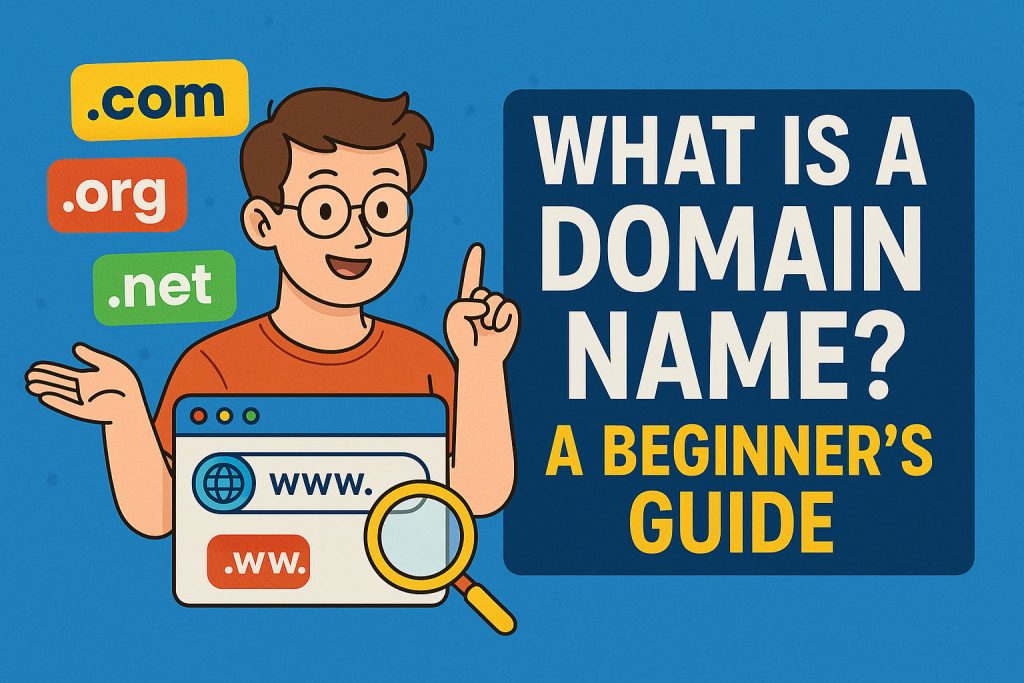If you’re thinking of launching a website, one of the first things you’ll encounter is domain name registration. But what exactly is a domain name, why does it matter, and how do you choose the right one?
Let’s break it all down in simple, beginner-friendly terms.
What Is a Domain Name?
A domain name is your website’s address on the internet. It’s what people type into their browser to visit your site—like yourbusiness.com or mycoolblog.net.
In technical terms, it’s a human-readable shortcut to your site’s IP address (a string of numbers that computers use to identify servers). Domain names make it easier for humans to navigate the web.
For example:
- Domain Name: google.com
- IP Address: 142.250.190.78
While both lead to the same place, which one would you rather type?
Why Domain Name Registration Is So Important
Domain name registration is the process of claiming your chosen domain name so no one else can use it. Once registered, it becomes your digital real estate.
Here’s why it matters:
- Brand identity: Your domain name represents your business or brand.
- Credibility: A custom domain looks more professional than a free one like
yourbusiness.wordpress.com. - Ownership: Registering your domain ensures you have control over your web address.
- SEO advantage: A relevant and memorable domain name can help with search engine rankings.
How Domain Names Work
Every domain name has two key parts:
- Second-level domain (SLD): This is the main part of the domain name (e.g.,
facebookinfacebook.com). - Top-level domain (TLD): This is the extension after the dot, like
.com,.org, or.tech.
There are hundreds of TLDs available now, including:
- Generic TLDs:
.com,.net,.info - Country TLDs:
.ng,.uk,.ca - Niche TLDs:
.blog,.store,.design
Choosing the right TLD can help position your website appropriately for your audience.
Domain Name Registration: Step-by-Step Guide
Step 1: Choose a Domain Registrar
A domain registrar is a company authorized to sell domain names. Popular options include:
Make sure your registrar is ICANN-accredited and offers good customer support.
Step 2: Search for Your Domain Name
Use the registrar’s search tool to check if your desired domain is available. If it’s taken, they’ll suggest alternatives.
Tips:
- Keep it short and memorable
- Avoid hyphens and numbers
- Use keywords related to your niche
Step 3: Choose the Right TLD
For most businesses, .com is still the gold standard. But if you’re targeting a local market, consider a country-specific TLD like .ng or .uk.
Step 4: Register and Pay
Once you’ve chosen your domain, follow the prompts to register it. You’ll need to:
- Provide your contact information
- Select the registration duration (typically 1–10 years)
- Choose optional add-ons like privacy protection
Step 5: Set Up DNS Settings
After registration, you can manage your DNS (Domain Name System) settings. This connects your domain to your hosting server or website builder.
Cost of Domain Name Registration
| Domain Registrar | Starting Price (Per Year) | Free Privacy Protection? |
|---|---|---|
| Namecheap | $9.58 | Yes |
| GoDaddy | $11.99 | No (paid add-on) |
| Google Domains | $12.00 | Yes |
| Bluehost | Free (with hosting) | Yes |
Prices vary by TLD and registrar. Keep an eye on renewal fees too—they can be higher than first-year promos.
Tips for Choosing the Perfect Domain Name
Choosing the right name is half the battle. Here are some tips:
- Be brandable: Choose a name that reflects your identity.
- Avoid trademark issues: Double-check that your name doesn’t infringe on existing trademarks.
- Think long-term: Choose a name that can grow with your business.
- Check social availability: Ideally, your domain name matches your social media handles.
Common Questions About Domain Name Registration
Can I own a domain name forever?
No. Domain names are leased annually (or in multi-year blocks). You must renew them to keep ownership.
What is domain privacy protection?
This hides your personal information (like name, email, address) from the public WHOIS database. Many registrars offer it free.
Can I transfer my domain to another registrar?
Yes. Domains can be transferred, but you must wait 60 days after initial registration.
Domain Name Registration & Website Hosting: What’s the Difference?
Think of it like this:
- Domain Name = Your street address
- Hosting = Your house
You can register a domain name without hosting. But to make your site live, you’ll need hosting.
Some companies (like Bluehost or Hostinger) offer domain + hosting bundles for convenience.
Final Thoughts: Registering Your Domain Name is the First Step
Your domain name is your gateway to the web. It defines your brand, builds trust, and helps visitors find you online. With so many tools and platforms available, domain name registration has never been easier or more affordable.
Take your time choosing the right name. Do your research, register it early, and pair it with reliable hosting for the best results.



